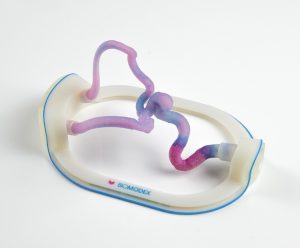Since the beginning of the history of medicine, the complexity of the human heart has been at the center of medical study. In Ancient Egypt, doctors had a pretty accurate knowledge of the internal organs and how they functioned. In particular, they knew a fair amount about the heart.
This is interesting because despite embalming was a common practice for the Egyptians, the knowledge was not shared or used by doctors. In Ancient Egypt, invasive surgery was an almost unheard of practice. Yet, the records reveal advanced knowledge of the heart and its function.

According to the Ebers papyrus, an Egyptian compilation of medical texts dated about 1550 BCE, and one of the six oldest known medical works, the Ancient Egyptian doctors wrote a rather accurate description of the circulatory system, noting the existence of blood vessels throughout the body as well as the heart’s function as center of the blood supply.
A slightly adapted translation of the Ebers papyrus to include modern language terms reads: “From the heart there are vessels to all four limbs, to every part of the body.”
Such fascination for the human heart has remained intact throughout the history of mankind. Building up on the ancient information of the heart and its functions, science and technology have come a long way. Today, we envision a future where a 3D-printed functional heart will be a reality that will save lives on Earth and beyond.
Why the urgency of 3D-bioprinting cardiovascular tissue
The prevalence of cardiovascular disease (CVD) represents a high economical burden to global healthcare systems. The annual cost of CVD to the economy is estimated to range between £19 to 35 billion in the United Kingdom and over $500 billion in the United States.
The World Health Organization (WHO) has reported that CVD is responsible for 17 million deaths every year, which translates to approximately 31 percent of all deaths globally. The WHO expects this figure to rise to over 23 million by 2030.
The cardiovascular disease technology market will exceed $40 billion by 2030, according to a report from IDTechEx, Cardiovascular Disease 2020 to 2030: Trends, Technologies, and Outlook.
According to research, 3D bioprinting of cardiovascular tissues for in-vitro and in-vivo applications is being investigated as a potential solution to better mimic the microenvironment which is typical of the human heart. Optimal cell viability and tissue vascularization, however, remain two of the main challenges in this regard.
3D bioprinting: The future of transhumanism?
We can expect that future applications of 3D bioprinting will include Transhumanism. Christopher Barnatt, futurist, freelance academic, keynote speaker, and presenter of ExplainingTheFuture.com told Navigate the Future that even when it is possible to bioprint thick tissues, like heart muscles, they are unlikely to be strong enough for immediate functional use. Barnatt says that a natural heart has grown over time, beating and hence being exercised for years.
So, it is likely that a 3D-bioprinted heart will need exercising to strengthen its muscle tissues before transplantation. Meaning, there will be a merge between robotics and 3D bioprinting, so there will be a need for robotic exercise machines for some bioprinted organs, such as the heart.
Other future applications for human organ 3D bioprinting include space and interplanetary medicine, slowing aging, and longevity.
Manufacturing human organs on demand: The art of 3D bioprinting
Before we get to the heart of the matter, let’s have a look at some basic background:
The manufacture of human organs — both artificial and bio-engineered— has been a major topic of research in biological engineering for the past decades.

Organ 3D-bioprinting utilizes techniques similar to conventional 3D-printing, where a printer uses a computer simulated model to lay down successive layers of material in order to produce a 3D object. In the case of bioprinting, such material is human tissue, also called biomaterial.
The concept of bioprinting was first demonstrated in 1988. It was not until 2004 that a new bio-printer was able to use live human cells without building an artificial scaffold first.
In 2009, Organovo created the first commercially available bio-printer, which was used to develop the first biodegradable blood vessel without a cell scaffold.
Ten years later, in 2019, a 3D-bioprinted miniature heart was successfully created. It was the size of a rabbit’s heart. The bioprinted heart matched the cellular, immune, and chemical characteristics of the individual the miniature heart was modeled from. However, the heart could not beat.
Regenerative medicine: Bioprinting a functioning human heart
Regenerative medicine studies and deals with the process of replacing, engineering, or regenerating diseased and damaged live cells, tissues, or organs in order to restore or establish their normal function.
Regenerative medicine uses various emerging technologies such as stem cell therapy, genetic and tissue engineering, and artificial and bioprinted organ technology with the aim to one day replace a damaged heart with a fully physiologically functioning 3D-bioprinted heart.
By the 2040s, we can expect to see some of the first widely available functional 3D bioprinted organs ready for transplantation, including corneas, which require simple layering techniques with no vasculature, unlike other more complex organs such as the heart.
Advanced 3D bioprinted functional complex and dense organs such as the heart will provide hope to individuals on transplant waiting lists. Indeed, the future applications of 3D bioprinting fully functional organs are going to dramatically improve and enhance human life and human life expectancy.
#
Editor:
To learn more, listen to a webinar When it Comes to 3D Printing the Future is Already Here
